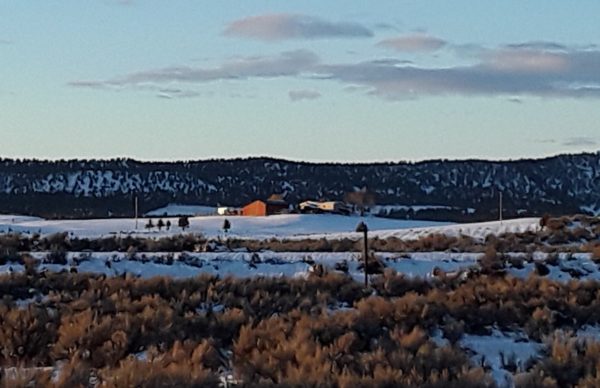Modoc County, March 18, 2020—Snow came several days this week, symbolically sealing off residents of the California Outback hermetically from others. In a county where the population is 2 people per square mile, it’s easy to be distanced socially. And a main complaint about living here—few social occasions—makes this vice a virtue.
The snow had piled up about nearly a foot around the house in drifts, but melting swiftly in the spring-like weather when the sun broke through. As I’ve done for the last several months, I took an afternoon walk of 2 miles—down a county road where for hours on end no vehicles drive by.
Today, though, an auto drove up, slowed down to pass, and then came back about 10 minutes later, and then back again. Finally as I neared my home, the truck approached another time and stopped at the top of my driveway, asking if I lived there. ‘Twas a middle-aged mama-type—of all things—handing out 2020 census packs. I laughed, asked if the envelope was clean. “I’m not sick,” she assured. Still, I took it, gingerly, and since I was wearing gloves for the walk, handled it carefully, and it’s setting outside right now, to overnight in sub-freezing weather—you can’t be too careful.
Perhaps it’s ironic the census taking has started during a pandemic. Later that day, I discovered the government announced census field work had been postponed for two weeks. Maybe there’s method in the madness—might have been fewer people around if they wait a few months, on the one hand—and on the other hand—well, that’s how economists begin a hypothesis. And there’s certainly a lot of hypothesizing going around among that crew these days: “What if we took a census and infected everyone in so doing it?”
Modoc County schools are shut down for the nonce. The movie theater was running “Call of the Wild” last weekend—urging folks to sit 6 feet apart—not hard in that theater and with our sparse population. A local supermarket announced on social media that any restaurant employee laid off could apply for a job at the store—a nice gesture.
Perhaps ironically, the library was planning a program to celebrate Earth Day at 50 years—and that’s been put on hold. I, too, have been wanting to mark Earth Day at 50—since I was an eager participant a half-century ago at Kennedy Junior High in Redwood City. Our ecologically-aware teachers in my eighth grade program made us do something for Earth Day. I read the book by Paul R. Ehrlich, The Population Bomb, and gave two speeches on campus about over-population—and China.
From our local library (which so far has been closed these past days because of staffing issues), I have a collection of books to use as reference for an article commemorating the anniversary. But it seems current events turned things upside down. In addition to Ehrlich’s The Population Bomb, I have Henryk Skolimowski’s A Sacred Place to Dwell, Robert B. Reich’s The Common Good, Edward Abbey’s Down The River and David Wallace-Wells’ The Uninhabitable Earth—all of these obtained before the call came to hunker down.
Anyone of these books contain passages that a more distraught-prone person could mine and quote in a rambling suicide note. I choose to remain optimistic, guarded, to be sure—and hand-sanitized—having in mind to weave from these authors’ words a quilt to memorialize the hope which had sprung from that first Earth Day so many years past.
Yes, I want to remain hopeful—and up to a week ago was—thinking that maybe the only candidate who made sense about our future—Sen. Bernie Sanders—was going to be the Democratic presidential nominee. But this may not to be—unless Sen. Joe Biden takes a cognitive nose-dive. The corporate interests and neo-liberal polistazzi have over-powered Sanders, but maybe not his movement cum revolution—so there’s still hope, delayed a few years and for some other candidate to take up the Vermont senator’s mantle.
I intend to craft a piece on Earth Day at 50—but in case I end up needing a ventilator when there’s none to be had, here’s a few passages from the aforementioned books—the authors’ words themselves for the reader to consider, a reflection on the state of our humble little—and only—home in the universe:
Paul R. Ehrlich in The Population Bomb: “Our problem would be much simpler if we only had to consider the balance between food and population. But in the long view, the progressive deterioration of our environment may cause more death and misery than any conceivable food-population gap. And it is just this factor, environmental deterioration, that is almost universally ignored by those most concerned with closing the food gap.
“It is fair to say that the environment of every organism, human and nonhuman, on the face of the Earth has been influenced by the population explosion of Homo sapiens. As direct or indirect results of this explosion, some organisms, such as the carrier pigeon, are now extinct. Many others, such as the larger wild animals of all continents, have been greatly reduced in numbers. Still others, such as sewer rats and house flies, enjoy much enlarged populations. But these are obvious results and probably less important than more subtle changes in the complex web of life and in delicately balanced natural chemical cycles. Ecologists…are especially concerned about these changes. They realize how easily disrupted are ecological systems…and they are afraid of both the short- and long-range consequences for these ecosystems of many of mankind’s activities.”
David Wallace-Wells in The Uninhabitable Earth: “It is worse, much worse, than you think. The slowness of climate change is a fairy tale, perhaps as pernicious as the one that says it isn’t happening at all, and comes to us bundled with several others in the an anthology of comforting delusions: that global warming is an Arctic saga, unfolding remotely, that it is strictly a matter of sea level and coastlines, not an enveloping crisis spare no place and leaving no life undeformed; that it is a crisis of the “natural” world, not the human one; that those two are distinct, and the we live today somehow outside or beyond or at the very least defended against nature, not inescapably within and literally overwhelmed by it; that wealth can be a shield against the ravages of warming; that the burning of fossil fuels is the price of continued economic growth; that growth, and the technology it produces, will allow us to engineer our way out of environmental disaster; that there is any analogue to the scale or scope of this threat, in the long span of human history, that might give us confidence in staring it down.”
Robert B. Reich in The Common Good: “Reviving the common good also depends on each of us taking responsibility for finding, sharing, and insisting upon public truth. By public truth I mean facts about what is happening around us that could affect our well-being, as well as clear logic about the significance of those facts and reasoned analysis about their practical consequences.
“Particular people have special responsibilities in this regard. We rely on scientists, researchers, professors, analysts, and journalists…to discover and report the truth. We depend on leaders of business, government, and nonprofits to relay the truth. We need fact-checkers, truth-tellers, whistle-blowers, and investigative reporters to help us uncover the truth when we’ve been lied to.
“But in recent years, the tendency to do whatever it takes to gain wealth or power has undermined truth, and called into question all these roles and responsibilities.”
Edward Abbey in Down the River: “As many have noted, the mass of men—and women—lead lives today of unquiet desperation. A frantic busyness (“business”) pervades our society wherever we look—in city and country, among young and old and middle-aged, married and unmarried, all races, classes, sexes, in work and play, in religion, the arts, the sciences, and perhaps most conspicuously in the self-conscious cult of meditation, retreat, withdrawal. The symptoms of universal unease and dis-ease are apparent on every side. We hear the demand by conventional economists for increased “productivity,” for example. Productivity of what? for whose benefit? to what end? by what means and at what cost? Those questions are not considered. We are belabored by insistence on the part of our politicians, businessmen and military leaders, and the claque of scriveners who serve them, that “growth” and “power” are intrinsic goods, of which we can never have enough, or even too much. As if gigantism were an end in itself. As if a commendable rat were a rat twelve hands high at the shoulders—and still growing. As if we could never have peace on this planet until once state dominates all others.”
Henryk Skolimowski in A Sacred Place to Dwell: “To worship God in our times is to save the planet. Religious devotion which does not include a service to the planet is idle, if not idolatrous. Other aspects of the worship of God are important, but saving the planet is of supreme importance. This is the primary work of our times.
“Let us emphasize: healing the planet and healing ourselves is spiritual work…Working on ourselves, to get our act together, is important, but it must not be separated from the Great Healing Act that we all must do—healing the planet, healing societies, healing the mind. What we witness in our present and forlorn and fractured world is the poisoned mind at work which in turn poisons everything around it.
“If we lose the environment, we lose God. It is as simple as that. The holocaust through the destruction of the environment will be slow. But it may be as deadly as one brought about by nuclear weapons. Praying to Absolute Deities endowed with divine attributes is well and good. But to save the integrity and beauty of creation, we need to be engaged in ecological prayer.
“Ecological prayer is acting out the ecological dimension of our existence, is bringing all beings into the wheel of our well-wishing. It is the meditative attitude of our daily action which helps to heal on all levels of being and is thus a form of ethics in action, based on solidarity and on compassion, which brings about a larger harmony in the long run…
“Ecological spirituality has a distinctive practical edge. It continually asks the following questions: How do you work on yourself so that you heal within? So that you heal your mind? So that you become a source of health and support for others? How do you help to heal the diseased educational system, the malfunctioning and carcinogenic social and political structures? How do you help to health the earth in your immediate vicinity? How does your lifestyle help to maintain the equilibrium in distant parts of the world by not contributing to frivolous over-consumption?
“All these questions are practical questions and spiritual questions at the same time. They require a new kind of awareness, a new kind of commitment, and a new kind of yoga.”
So, now what would this group of writers say about current events? The events speak for themselves: The air is clearing over China. Carbon dioxide levels are falling across the world. The canals of Venice are clearing up—dolphins are returning there.
The 1918 Influenza looms large in my mind—family lore about that epidemic: My mom’s mom, who was pregnant, tried to get her brother, Ely, in the Navy released. She went to his commanding officer and said she was his wife—and pregnant—needed him home. It didn’t work. Ely died from the flu soon after.
Economists have another favorite prefix phrase: In the long run. In the long run, the pandemic may bring unintended benefits for the Earth—if maybe humans we can be aware—have insight and then act with intention. A pandemic as people celebrate Earth Day at 50 is ironic as it can be educational—an observation I hope is neither didactic nor insensitive.




